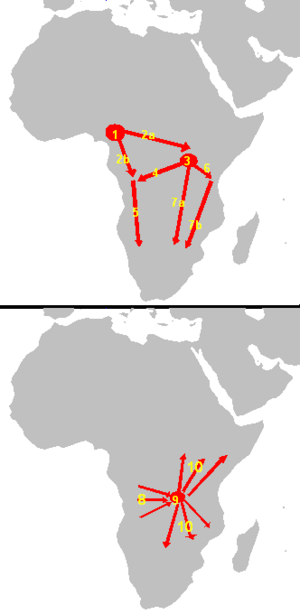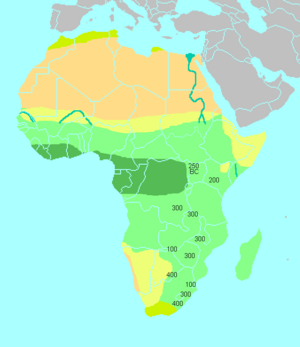Bantu expansion facts for kids
The Bantu expansion was a huge movement of people in ancient Africa. It involved groups who spoke early forms of the Bantu languages. These people started their journey from an area in West Africa and Central Africa. As they moved, they spread across much of sub-Equatorial Africa.
During this long journey, the Bantu-speaking settlers met other groups already living in these areas. These groups were often hunter-gatherers or herders. The Bantu people either joined with them, moved them out, or absorbed them into their own communities.
We know about this expansion because of several clues. One big clue is language. Many languages spoken across sub-Equatorial Africa today are very similar. This suggests they all came from a common origin. The main area where Bantu languages started was in southern Cameroon. Also, scientists have studied people's genetics. They found evidence of a large human migration from Central Africa. This shows that people moved and mixed with local populations.
Experts believe this expansion happened in at least two main waves. It took place between about 4,000 and 2,000 years ago (from around 2,000 BC to AD 1). One wave went across or along the northern edge of the Congo forest towards East Africa. Another wave, and possibly more, moved south along Africa's Atlantic coast. They went into countries like the Republic of the Congo, Gabon, and Angola. Some also moved inland along the rivers of the Congo River system. The Bantu expansion reached South Africa quite early, possibly by AD 300.
Contents
Why Did the Bantu People Move?
Experts who study Bantu history think the expansion likely began in the highlands between Cameroon and Nigeria. There's a region called Mambilla Plateau where some people still live who are thought to be descendants of "the Bantu who stayed home." This suggests that this area was the starting point.
At first, archaeologists thought they could find similar ancient cultures along the paths the Bantu speakers took. Linguists, who study languages, tried to figure out what tools and items these early people used. They believed the expansion happened because of new developments. These included better ways to farm, making ceramics (pottery), and using iron. These new skills allowed them to live in and use new types of environments.
The Bantu expansion led to the Khoisan hunter-gatherers, who lived in Southern Africa, either moving away or joining the Bantu groups. In East Africa and Southern Africa, Bantu speakers might have learned how to keep livestock from other groups they met. These groups spoke Cushitic languages and Nilotic languages. Herding practices reached the far south of Africa even before the Bantu-speaking migrants arrived.
All the evidence – from archaeology, linguistics, genetics, and the natural environment – shows that the Bantu expansion was a very important human migration. The movement of Bantu-speaking people from the Cameroon/Nigeria border region changed the genetic makeup of much of sub-Saharan Africa. It led to a lot of mixing between the newcomers and the local people. A recent genetic study in 2023 confirmed that the expansion started about 4,000 years ago in West Africa. It also showed that Bantu speakers mixed a lot with local groups as they expanded.
One theory, based on dental evidence, suggests that the ancestors of West African and Proto-Bantu peoples might have come from the western Sahara desert. They may have moved south around 7000 BC as the Sahara became a desert. From Nigeria and Cameroon, early farming Bantu peoples began to move. They split into East Bantu peoples (like those in the Democratic Republic of Congo) and West Bantu peoples (like those in Congo and Gabon) between 2500 BC and 1200 BC.
Bantu Languages: A Huge Family
The Bantu languages are part of a much larger group called the Atlantic-Congo language family. This family includes many languages spoken across Western, Central, and Southern Africa.
Most Atlantic-Congo languages, including almost all Bantu languages, use tone. This means the meaning of a word can change depending on the pitch of your voice. They usually don't change word endings to show things like singular or plural (called inflection). However, they have many different noun classes, sometimes as many as two dozen! The main part of a verb usually stays the same. Other words or helper verbs are used to show when something happened (past, present, future) or how it happened.
Life Before the Expansion
Before Bantu-speaking farmers arrived, Central, Southern, and Southeast Africa were home to different groups of people. These included Pygmy foragers, Khoisan-speaking hunter-gatherers, Nilo-Saharan-speaking herders, and Cushitic-speaking pastoralists.
Central Africa
It's thought that Central African Pygmies and Bantu people came from a common ancestor about 70,000 years ago. Many Batwa groups today speak Bantu languages. However, they also have many words that are not Bantu. These words are often about plants, collecting honey, or other things related to the forest. This suggests they might have had their own language before.
Southern Africa
Before the Bantu expansion, Khoisan-speaking peoples lived in Southern Africa. Many of their descendants have mixed with other groups and now speak different languages. Some still live by foraging, often working for nearby farmers in dry areas like the Kalahari desert. A larger number of Nama continue to raise livestock in Namibia and South Africa.
Southeast Africa
Before the Bantu people arrived in Southeast Africa, Cushitic-speaking peoples had moved into the region. They came from the Ethiopian Highlands and other northern areas. The first groups settled around Lake Turkana and parts of Tanzania about 5,000 years ago. Later, around AD 1000, some Eastern Cushitic speakers also settled in northern and coastal Kenya.
Khoisan-speaking hunter-gatherers also lived in Southeast Africa before the Bantu expansion. Nilo-Saharan-speaking herders were another group living there before the Bantu people arrived.
How the Expansion Unfolded
The Journey Begins

Evidence from languages, archaeology, and genetics shows that there were different waves of migration. Both West African and East African Bantu speakers moved into Southern Africa. In some places, the arrival of Bantu speakers meant that the original populations were largely replaced. In other areas, Bantu languages spread because existing populations started speaking them and mixed with the newcomers. For example, this happened with African Pygmies and the Lemba in Southern Africa. Where Bantu was adopted, older African languages were likely spoken. Some of these older languages might have influenced local Bantu languages, like the click sounds found in some of them.
From 3000 BC to AD 500
It seems the movement of Bantu-speaking people from their homeland in West Africa started around 4000–3500 BC. Early ideas suggested they used iron and farmed from the beginning. However, clear archaeological proof of iron use doesn't appear until around 400 BC, though they were farmers earlier.
One branch, possibly not distinct in language, followed the coast and the major rivers of the Congo system south. They reached central Angola by about 500 BC.
There were people living in these regions when the Bantu expansion happened. Pygmies are their closest living relatives today. Genetic research in Cabinda Province suggests that only genetic groups from West Africa are found there now. This might mean a complete replacement of the earlier population. In South Africa, however, there was more mixing of different groups.
Further east, Bantu-speaking communities reached the great Central African rainforest. By 500 BC, pioneering groups moved into the savannas to the south. These areas are now the Democratic Republic of Congo, Angola, and Zambia.
Another group of migrants moved east about 3,000 years ago (1000 BC). They created a new population center near the Great Lakes of East Africa. This area had a rich environment that could support many people. The Urewe culture was important in the Great Lakes region between 650 BC and 550 BC. It was one of Africa's oldest places for smelting iron. By the first century BC, Bantu-speaking communities in this region developed ways to make carbon steel.
Small groups moving southeast from the Great Lakes region traveled faster. Their first settlements were spread out near the coast and rivers. This was because farming was harder away from water. Archaeological finds show that by 100 BC to 300 AD, Bantu-speaking communities were on the coasts of Misasa in Tanzania and Kwale in Kenya. These communities also mixed and married with the people already living there. Between 300 AD and 1000 AD, these communities connected with Arabian and Indian traders through the long-standing Indian Ocean trade route. This led to the development of the Swahili culture. Other early groups reached modern KwaZulu-Natal in South Africa by AD 300 along the coast. They reached the modern Limpopo Province by AD 500.
From the 11th to 17th Century
Between the 11th and 16th centuries, powerful Bantu-speaking states began to form. These were larger than the smaller local chiefdoms. Important early kingdoms included the Kingdom of Kongo in present-day Angola and the Democratic Republic of the Congo. The Bunyoro Kitara Kingdom was in the Great Lakes region. The Kingdom of Mapungubwe (around 1075–1220) was in present-day South Africa. Along the Zambezi River, the Monomatapa kings built the Great Zimbabwe complex.
The Swahili city-states also started early in this period. These included important trading centers like Lamu, Mombasa, Kilwa, Pate, and Malindi. The Swahili traded with inland kingdoms, including Great Zimbabwe.
These larger states formed more often from the 16th century onwards. This likely happened because there were more people, which led to more specialized jobs, including military power. It also made it harder for people to move away. Other reasons for state formation included increased trade among African communities and with European and Arab traders on the coasts. New technologies in economic activities and new ways of showing the power of royalty also played a role. Other important inland centers from this time include Bigo bya Mugenyi in Uganda, Thimlich Ohinga in Kenya, and the Kweneng' Ruins in South Africa.
See also
- Bantu peoples
- Matrilineal belt
- Pre-modern human migration



